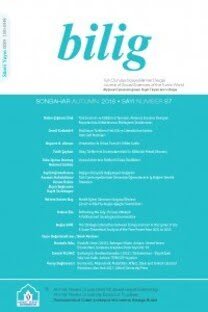Yeniçağ Osmanlı İmparatorluğunda Bir Apolojist/Reddiye Örneği
An Example of Polemic/Apologetic Literature in the Early Modern Ottoman Empire
Polemic/ apologetic literature, Ottoman, Kadızadeli, Panagiotis Nikousios Vani Mehmed Efendi,
___
Anthony, S.W. (2016). “Muhammad, Menaahem, and the Paraclete: New light on Ibn Ishāq's (d. 150/767): Arabic version of John 15: 23-16:1”. Bulletin of the School of Oriental and African Studies 79 (2): 255-278.Muḥyī al-Dīn b. ʿArabī (d. 638/1240). Miftāḥ al-d̲j ̲afr al-d̲j ̲āmiʿ, mss. Istanbul-Hamidiye. Ism. Ef. 280.
Argyriou, A. (1971). “Pachomios Roussanos et l’Islam”. RHPhR 51 (2): 143-64. ___________ (1987). “La littérature greque de polémique et d’ apologétique à l’adresse de l’islam au XVe siècle. Examende quelques problems d’ordre phililogique”. Mélanges Fr. Thiriet. Byzantinische Forschungen: 253-277.
___________ (2013). “The Greek polemic and apologetic literature against Islam during tourkokratia”. Theologia 1: 133-167.
Aydın M. (2012). Müslümanların Hristiyanlara Karşı Yazdığı Reddiyeler ve Tartışma Konuları. Ankara: Diyanet Vakfı Yayınları.
Baer, David Marc (2008). Honored by the Glory of Islam: Conversion and Conquest in Ottoman Europe. Oxford: Oxford University Press.
Bayraktar-Tellan, E. (2012). “The Orthodox Church of Crete, 1645–1735: a case study of the relation between sultanic power and patriarchal will”. Byzantine and Modern Greek Studies 36 (2): 198-214.
Burman, Thomas E. (1998). “Tafsīr and Translation: Traditional Arabic Qurʾān Exegesis and the Latin Qurʾāns of Robert of Ketton and Mark of Toledo”. Speculum: 703-732.
Cantacouzenos, J. (1828) Corpus Scriptorium Historiae Byzantinae. Ed. Ludwig Schopen. 3. Vols. Bonn:Weber. 1828-32. Cantemir, Demetrius (1734). The History of the Growth and Decay of the Othman Empire, Part I. Containing the Growth of the Othman Empire from the Reign ofOthman the Founder to the Reign of Mahomet IV, that is, from the Year 1300, to the Siege of Vienna, in 1683. Tr. N. Tindal. London.
Casale, C. (2010). The Ottoman Age of Exploration. Oxford: Oxford University Press.
Chalkiadakis, E. (2012). Patriarchate of Jerusalem: History, Society, Civilization. Heraklion. University Ecclesiastical Academy of Crete. Costigliolo, Marica (2014). “Perspectives on Islam in Italy and Byzantium in the Middle Ages and Renaissance”. Nicolas of Cusa and Islam: Polemic and Dialogue in the Late Middle Ages. Eds. Ian Christopher Levy, Rita Georg-Tvrtković
and Donald F. Duclow. Leiden. Brill.
Cucarella Diego R. Sarrió (2015). Muslim-Christian Polemics Across the Mediterranean: The Splendid Replies of Shihab Al-Din Al-Qarafi, 684-1285. Leiden. Brill.
Çolak, H. (2015). The Orthodox Church in the Early Modern Middle East: relations between the ottoman central Administration and the Greek Orthodox Patriarchates of Antioch, Jerusalem and Alexandria. Ankara: Türk Tarih Kurumu.
De La Croix (1715). Etat Present des Nations et Eglises Grecque, Armenienne et Maronite en Turquie. Paris. Ebied, Rifaat and David Thomas (eds.). (2005). Muslim-Christian Polemic during the Crusades: The Letter from the People of Cyprus and Ibn Abī Ṭālib al-Dimashqī’s Response. Leiden: Brill.
Fahd, T. (2012). “Ḥurūf”. Encyclopaedia of Islam. Second Edition. Ed. P. Bearman, Th. Bianquis, C.E. Bosworth, E. van Donzel, W.P. Heinrichs. Consulted online on 27 September 2016. http://dx.doi.org/10.1163/1573-3912_islam_SIM_2971. Fahd, T. (2012). “D̲j ̲afr”. Encyclopaedia of Islam. Second Edition, Ed. P. Bearman, Th. Bianquis, C.E. Bosworth, E. van Donzel, W.P. Heinrichs. Consulted online on
27 September 2016. http://dx.doi.org/10.1163/1573-3912_islam_SIM_2971.
Galland, Antoine (1881). Journal d’ Antoine Galland pendant son séjour à Constantinople, 1672-1673. Paris. Georgiades Arnakis, G. (1951). “Gregory Palamas among the Turks and Documents of His Captivity as Historical Sources”. Speculum 26 (1): 104-118.
Greene, Molly (2002). A Shared World: Christians and Muslims in the Early Modern Mediterranean. Princeton: Princeton University Press.
Hagios Maximos o Graikos, o Phōtistes Ton Rōsōn ē Prosōpikotes Tou, ē Prosphora Tou, Apanthisma Tōn Logōn Tou (1991). Iera Monē Osiou Gregoriou Agiou Orous. Thessaloniki: Ekdoseis Harmos.
Haney, Jack V and W. Fink (1973). From Italy to Muscovy: the life and works of Maxim the Greek. C. 19. Bonn: Humanistische Bibliothek: Abhandlungen.
- ISSN: 1301-0549
- Yayın Aralığı: Yılda 4 Sayı
- Başlangıç: 1996
- Yayıncı: Ahmet Yesevi Üniversitesi
Mahtumkulu’nun Şiirlerinde Mert ve Namert Tipi
Yeniçağ Osmanlı İmparatorluğunda Bir Apolojist/Reddiye Örneği
Türk Runik Alfabesindeki “Çift Ünsüz” İşaretleri Üzerine
Bir Sözlüksel Bilmece: Redhouse’un Kayıp Türkçe Sözlüğüne Ne Oldu?
Nasreddin Hoca’yı “Kültürlerarası Temas” İmkânı İçin Yeniden Okumak
İsrail’in Yeni Çevre Stratejisinde Güney Kafkasya
Tehlike Altındaki Dil: Sarı Uygurca
Kırgızistan’da Basmacı Hareketiyle İlgili Yeni Bilgiler 1925-1934
